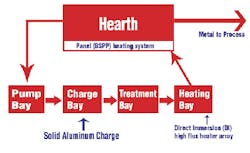Isothermal Melting Research Now into New Stage
The U.S. Dept. of Energy research effort aimed at developing a new commercial-scale, energy-efficient furnace for melting aluminum is being continued in a new project. The original project — Energy Efficient Isothermal Melting (ITM) of Aluminum — resulted in a direct immersion, electric-resistance melting system that offers +70% thermal efficiency and low levels of melt loss (-1%.)
DOE’s Industrial Technologies Program is coordinating the research with several industrial partners. They include Apogee Technology Inc., GM Powertrain, and Aleris International. Other research partners are the Argonne National Laboratory and Drexel University.
As detailed by ITP, most primary and secondary aluminum operations use natural gas-fired reverberatory furnaces. In reverb melting, most of the process heat is transferred to the surface of the molten aluminum through refractory radiation and some convection.
In the U.S., according to ITP figures, approximately 67 trillion Btu/year are consumed to melt and hold the 32 billion lb of molten aluminum. Gas furnaces use approximately 2,100 Btu/lb to melt aluminum — but lose approximately 2-4% of the metal to oxidation. The thermal efficiency of reverb furnaces is just 20-45%, according to ITP.
ITM uses less than 650 Btu/lb to melt aluminum, the agency indicates, and reduces oxidation losses to less than 1%. It estimates that ITM will save 50% of the energy used in reverb melting, and reduce airborne emissions by 80% (the figure includes losses from electricity generation and transmission, and savings from reduction of metal oxidation).
The initial ITM research developed a stand-alone furnace that was installed and operated at Aleris Rolled Products in Newport, OH, in 2005. That furnace achieved a production rate of 5,000 lb/hour, which led to plans for the extension. ITP reports that the extension project will develop a combined system to efficiently melt and deliver molten metal.
As previously reported in FM&T, what makes isothermal melting so efficient is the use of immersion heaters in a series of melting bays inside the vessel. Each bay contributes to an efficiency improvement.
A pumping bay provides good circulation in the isothermal systems. This circulation promotes better mixing for purifying and alloying, and more uniform temperature profiles throughout the molten pool. The heating bay is the major source of efficiency gain, where electricity is converted into heat through the immersion heaters and conducted directly to the molten metal. The heating bay raises the molten metal temperature (typically less than 90°F) just high enough to melt the solid metal being charged into the pool. The charging bay and treatment bay provide more compact areas to control and introduce solid charge or alloying and purifying elements compared to opening a heath door and exposing the entire surface of the pool and refractory to the plant environment.
The challenge to developing the ITM system was creating immersion heaters that could provide the high heat flux and the chemical, thermal and mechanical robustness required in an industrial molten aluminum environment. The heaters were developed by Apogee Technologies, which researched new materials, fabrication techniques, and quality-control systems to build devices. They have a heat flux capability of approximately 70,000 Btu/hr-ft2 (5-10 times more than standard commercial heaters) and external coatings that protect against corrosive molten aluminum.
By ITP projections, if 60% of the U.S. aluminum reverb melting capacity were replaced by isothermal melting, then the process would save approximately 18.6 trillion Btu and reduce emissions by over 180,000 metric tons of carbon equivalent by 2020.
“The system involves preparing the metal at off site locations using ITM furnaces and transporting it over the road to casting operations using ITM immersion heaters in transfer vessels,” the agency explains about the extension of the research program. “Docking stations at remote casting operations receive these vessels which allow them to be drawn down over a period of time required by the casting processes, essentially displacing on site holding furnaces.
“These holding vessels operate at